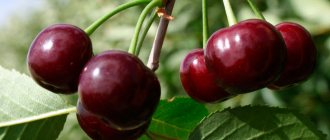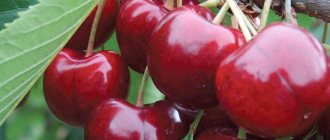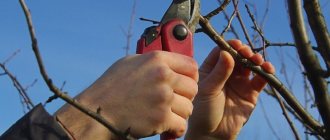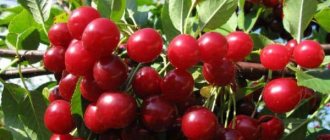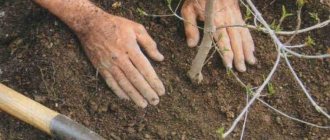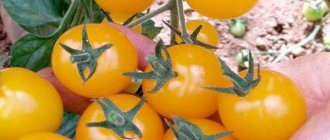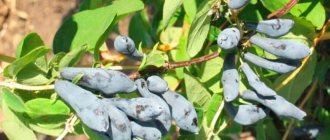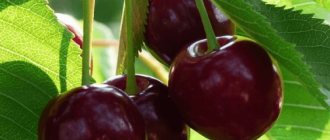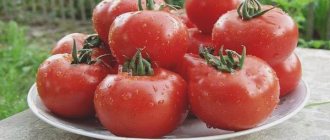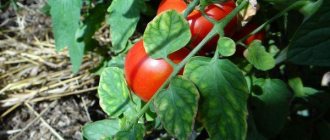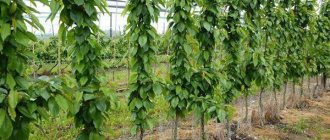General varietal characteristics
The variety has good resistance to both heat and drought, as well as low winter temperatures. Therefore, today it has spread widely throughout Russia. “Izobilnaya” is included in the national state register of selection achievements for the Volga-Vyatka and Ural regions.
The first ripe berries appear on the cherry tree in the second half of August. The variety is characterized by non-simultaneous ripening of fruits. Therefore, the harvest stretches for 2-3 weeks.
Description of cherry tree
The plant of this cherry variety is a bush about 2.5-3 meters high. With such a height of the cherry tree, the crown has quite modest dimensions, its diameter does not exceed two and a half meters. Round-oval in shape, it has medium density and a moderate number of leaves. Small oval-shaped buds form on light brown thin shoots. The leaf blades are dark green and have a narrow oval shape. The upper surface of the leaves is smooth, almost glossy, while the lower surface is matte and rough.
Large, snow-white flowers are collected in inflorescences of 5-7 pieces. The light green petioles are thin and long. Due to the late ripening of the variety, flowering occurs in early June, when the bulk of the fruit trees have already bloomed. Late flowering is highly valued in regions where spring frosts return more than once and affect early flowering plants.
It should be noted that during flowering, the “Abundant” cherry is stunningly beautiful and takes on the appearance of ornamental plants. This tree will decorate any area.
Features of pollination
The undoubted advantage of the variety is its self-fertility. The tree bears fruit well in single plantings and immediately after flowering forms ovaries without the help of pollinating varieties. This quality is very valuable for owners of small garden plots where it is not possible to plant several varieties of trees at once.
Characteristics of fruits and their use
The berries of “Izobilnaya” are quite modest in size. The weight of one cherry rarely exceeds 3 grams. Round in shape, they are slightly flattened on the seam side. The skin is medium thick and dark red. The bright red flesh is very juicy and characterized by a sweet and sour taste. Sugar content is about 8%, acid content is about 2%. This indicates a good, balanced taste. The stone is small and easily separated from the pulp.
When picked and separated from the stalk, despite their juiciness, the berries do not wrinkle or flow. The fruits of “Izobilnaya” are not prone to cracking. The combination of these qualities allows them to be transported over long distances and grown for sale.
The extended fruiting period allows you to enjoy fresh berries until September. This berry is also excellent in processing. Cherry compotes, preserves and jams are tasty and aromatic.
Interesting! Cherries contain a huge amount of vitamins, minerals and various organic acids. Daily consumption of fresh berries normalizes the functioning of all vital systems of the body.
Productivity
“Izobilnaya” begins to bear fruit 3-4 years after planting. The harvests are immediately noticeable in abundance. From a ten-year-old tree you can collect more than 10 kg of berries. This characterizes the variety as high-yielding, which fully justifies its name. With good care, cherries will bear fruit for thirty years.
What are the pros and cons
Before planting a seedling, the strengths and weaknesses of the variety that each crop has are studied.
The undeniable advantages of Izobilnaya include:
- Late flowering, thanks to which the flowers of the variety do not experience the negative effects of returning spring frosts.
- The variety is self-fertile, which allows you to save space on the site for planting pollinators.
- High frost resistance, which makes it possible to plant Izobilnaya in regions with harsh, long winters.
- Harvest volumes. Despite its compact size, cherries consistently bear fruit and produce a large number of berries.
- Long period of tree life with regular anti-aging pruning (about 30 years).
The disadvantages of stone fruit culture include:
- Small size berries.
- Late fruit ripening.
- Sourish taste of cherries.
Based on these characteristics, we can conclude that Izobilnaya has many more advantages than disadvantages.
Features of agricultural technology
Since the “Izobilnaya” cherry enters the growing and flowering phase late, it is most advisable to plant in the spring. The optimal time would be April. The soil has already thawed sufficiently, but the seedlings are still dormant.
When choosing a place for cherries, you should be guided by the following rules:
- the area should be open to sunlight;
- it is desirable that the place is hidden from cold gusty winds;
- You should not choose a site where fruit trees have grown for a long time;
- the soil should be well drained and fertile.
The seedlings are planted in planting pits filled with nutritious soil mixed with fertilizers. Experienced gardeners recommend adding well-rotted manure, superphosphate and potassium sulfate to the soil. Before planting the seedling, a wooden peg is driven a little away from the center of the hole; a young tree will subsequently be tied to it. The roots of the cherry are well straightened so that they are not twisted or bent, and gradually sprinkled with earth. Upon completion of planting, the tree is watered and tied to a peg. To retain moisture, the soil near the trunk is mulched.
Advice! During planting, the roots of the seedling must be shaken periodically. This will prevent the formation of unwanted air voids at the roots, which can lead to their drying out and death of the tree.
Tree care
In the first year of planting, cherry seedlings require weekly watering. If the season is rainy, the frequency of irrigation can be reduced. Starting from the second year, watering is no longer a mandatory procedure, since “Izobilnaya” is a drought-resistant variety.
But in dry years, additional moisture will significantly increase the quality and quantity of the crop. The procedure is carried out in accordance with the life cycle of the cherry, namely during periods when the need for moisture is especially increased:
- immediately after the tree has finished blooming;
- during the period of ovary formation;
- after collecting the main part of the harvest;
- in autumn, after the leaves have dropped.
The watering rate per tree changes with the age of the plant:
- for a one-year-old seedling – 1-2 buckets;
- for young cherries – 2-3 buckets;
- for mature fruit-bearing trees – 5-6 buckets.
Feeding
If the “Izobilnaya” cherry grows on fertile, chernozem soil, then fertilizers should be applied only from the fourth year of planting. Until this time, the fruit tree will have enough natural nutrients and substances added to the soil during planting.
You may be interested in: Pruning cherries: when and how to do it correctlyCherry varieties resistant to coccomycosis and moniliosis for the Moscow regionCherry “In Memory of Vavilov”: growing features and care
In poor and depleted areas, fertilizing is applied from the second year after transplanting to a permanent place. Approximate fertilizer application scheme recommended by experts:
- as soon as the snow has melted, nitrogen fertilizers are applied to the wet soil;
- at the end of May, repeat fertilizing with nitrogen-containing compounds;
- in the summer, several feedings are carried out with herbal infusions;
- after the ovaries fall off, the tree crown is sprayed with a solution of iron sulfate;
- In September, potassium and phosphorus fertilizers are applied.
Application rates depend on the composition of the soil and the age of the trees.
Advice! To prepare a herbal cocktail for fertilizing cherries, you need to fill any sized container ½ full with young nettle tops and dandelions (roots and leaves), and fill it with water. The container is placed in a sunny place and protected from precipitation. To speed up the fermentation process, add a little yeast or a crust of rye bread to the infusion. After a week, the natural fertilizer will be ready for use.
Cherry pruning
Trees of this variety are pruned very carefully and moderately. Drastic pruning will cause severe stress to the cherry tree and may destroy it. For the first six years, experts recommend limiting yourself to sanitary pruning only. In autumn, after the leaves have fallen, dried, damaged and diseased branches are removed. Every year, all shoots that form on the trunk below the grafting site are removed.
Starting from the seventh year of growth, thinning pruning is carried out every two to three years:
- remove branches that thicken the crown;
- cut out or shorten shoots that interfere with the normal growth of skeletal branches;
- trim the main trunk if it is more than 20 cm higher than the tops of the frame branches.
Gardeners often complain about the appearance of a large number of shoots near the main tree. This phenomenon is a signal that the cherry is not in the best condition. The cause may be the plant being damaged by a disease, too much pruning or other mechanical damage. You need to try to eliminate the cause of the appearance of shoots, and cut off the grown shoots to the very roots, without leaving stumps.
Cherry Izobilnaya
This variety of cherry was obtained through the selection of planting material that grew as a result of free pollination of plants of Michurin varieties. Izobilnaya was bred in the Sverdlovsk region.
Description of the cherry variety Izobilnaya
This is a late-ripening plant that blooms in the last ten days of May or the first ten days of June. It will begin to bear fruit from mid-August. In a year, one plant can produce up to 10 kilograms.
On a note! The Izobilnaya cherry begins to bear fruit only in the third or fourth year after planting. Then it produces a harvest every year; it becomes most abundant in the 8th–10th year. Further, cherries continue to maintain high yields.
The bush cherry itself has the following characteristics:
- height in the standard case is 2.5 meters, although the bush can grow up to three;
- the crown is oval-shaped, the density (both leaves and shoots) is average;
- The length of the buds is approximately 3 mm, they are located on the branches of the plant, slightly deviating to the side;
- leaves are concave in shape, glossy texture.
In turn, the berries have the following parameters:
- the fruit is round in shape, on the side on which the seam is located, it is somewhat flattened, reminiscent of some varieties of cherries;
- its width is 16 mm and its height is 15;
- weight from 2.5 to 3 g, in particular the weight of the stone is 0.21 g;
- the taste of the berry pulp is sweet and sour, the cherry is juicy;
It can also be used for fresh food, but the best option is to make jam or juice.
Features of cultivation
During the spring, before the plant blooms, the summer resident needs to apply a combined fertilizer. Its proportions can be as follows:
- 10 liters of water;
- 15 g potassium chloride;
- 25 g superphosphate;
- 10 g urea.
The described solution can also be used during the period when the cherry blossoms are abundant, adding it every half month.
Another option is for 50 liters of water, 10 liters of cow dung and a bucket of ash. This solution is kept for five days. Next, spend half a bucket per bush. After applying this composition, you need to water the plant using 2 buckets of water.
Important! In summer, it is recommended to fertilize with mineral-based fertilizer.
In the period preceding bud break, cherries are treated with Bordeaux mixture in solution. Next, the trunks and roots of the bushes are sprayed with vitriol. When the plant fades, it is treated with Decis or Topsin-M.
In autumn, the soil around the cherry tree needs to be dug up; the farther from the trunk, the deeper the soil needs to be dug up.
Plant care also includes removing new shoots that grow near its roots.
Advantages and disadvantages
Cherry Abundance (Abundant) has the following benefits:
- excellent frost resistance, the plant bark does not suffer at all from low temperatures;
- late flowering, which gives it the opportunity not to suffer from cold mornings in the spring;
- self-fertility, the plant does not depend on bees or the presence of other cherry pollinators;
- high yield.
The disadvantages of this variety include:
- small size of the berries themselves;
- their non-simultaneous maturation.
However, this is only unprofitable if you want to quickly harvest, and if you eat the berries fresh, this property will not be a disadvantage, but rather an advantage.
Disease and pest control
The variety has average resistance to diseases and pests. One of the most common diseases in Izobilnaya is coccomycosis. The disease manifests itself as yellowing of the leaves and the appearance of characteristic black dots on them. On the inside of the leaves, bulges form in which the disease spores multiply.
Treatment and prevention of coccomycosis is carried out with copper-based preparations. Cherry trees are sprayed in the spring (before the onset of sap flow) and in the fall (after leaf fall).
This treatment will also destroy all overwintered pest larvae. If parasites attack a tree at the height of the summer season, then use approved insecticides or folk remedies, for example, wormwood infusion or a solution of laundry soap.
Harvest and storage
As noted above, the fruiting of “Izobilnaya” lasts for 2-3 weeks. Accordingly, harvesting is carried out in 2-3 steps. The fruits are collected in dry and warm weather. Berries intended for storage and transportation are cut with scissors along with the petioles. Cherries are transported in wooden boxes with a volume of 2-3 kilograms.
Cherries are not fruits intended for long-term fresh storage. Two weeks is the maximum period during which “Izobilnaya” will retain full freshness in the refrigerator.
Description of the tree and berries
It’s worth starting your acquaintance with Izobilnaya with a description of the variety in order to evaluate all its positive and negative qualities:
- Cherry belongs to the shrub type, its height rarely exceeds 2.5 meters.
- The crown of the tree is compact in size, medium dense, oval in shape.
- The leaves are dark green, narrowly oval in shape.
- The flowers are white in color, collected in inflorescences of 4-6 pieces.
- The dark red berries weigh up to 3 grams. The shape is round.
- The stone makes up 7.5% of the total mass of the fruit and is separated medium-sized.
Abundant fruiting is achieved by following the rules for growing and caring for stone fruit. They are no different from agricultural techniques for other cherries. Watering, timely pruning, adding nutrients, protection from diseases and pests - everything that is needed for full growth and development.
According to professional tasters, the fruits of the Izobilnaya variety received 4 points out of 5 possible.
Advantages of the variety
According to reviews from gardeners, “Izobilnaya” is not an ideal cherry variety, but at the same time they note a number of positive characteristics. We list the main ones:
- cherries begin to bear fruit in the third or fourth year of planting;
- the variety grows well in various climatic conditions;
- good cold resistance;
- trees tolerate drought well;
- cherry has a small crown that is not prone to thickening;
- high yield rates;
- ability to self-pollinate;
- late flowering (prevents freezing of flowers and ovaries);
- good taste of fruits;
- the berries are suitable for transportation.
Description of winter-hardy cherry variety Izobilnaya
Description of the variety
A cherry called Izobilnaya, the variety of which is described in this article, was bred in the late 90s at the Sverdlovsk horticulture breeding station from Michurin’s free-pollinated varieties. It is a low (2.5–3 m) bush with a fairly compact oval crown of medium density. The leaves are narrow, oblong, glossy, dark green on the surface, several shades lighter below. The shoots are located at an acute angle and rush upward.
Cherries bloom late - at the end of May, in some regions at the beginning of June, since the variety is late. The flowering is lush, each inflorescence contains 5–7 freely arranged white flowers. Fruiting occurs on young annual growth and on bouquet branches.
The fruits of the Abundant cherry are not large in size. Their weight is only 2.5–3 g and their width is about 15 mm. The skin is dark red, the flesh is scarlet, tender, very juicy, with a satisfactory sweet and sour taste, with a hard-to-separate bone. The detachment from the stem is easy and dry. The berries do not crack due to weather conditions and overripeness, and are ideal for technological processing.
Characteristic
The Izobilnaya cherry variety is characterized by late (second ten days of August) and gradual ripening, which is why harvesting should be done in stages, 2-3 times. Trees begin to bear fruit at the age of 3–4 years. From this point on, the yield increases every year, and reaches its maximum at the age of 8–10 years, after which it remains at a consistently high level. Cherries of this variety are long-lived - with regular anti-aging pruning, rooted plants can live up to 30 years.
Among all varieties of cherries, Izobilnaya is one of the most frost-resistant. Even in the harshest winters, no freezing of buds or wood was observed, and the late growing season makes it possible to avoid spring frosts.
In addition, it tolerates drought well, which makes it possible to grow this variety in almost all regions of the country. The trees are self-fertile, but can also be pollinated by other plants with the help of insects.
Disease resistance is average. Quite often, cherries are affected by stone fruit diseases of fungal origin: moniliosis and coccomycosis. Sometimes it is damaged by cherry aphids and slimy sawflies, but in general the variety has a high technological assessment, and according to experts, it can be grown not only in private gardens, but also on an industrial scale, in particular in intensive gardens.
Advantages and disadvantages
Like any berry, cherries of this variety have their own advantages and disadvantages. There are undoubtedly more of the first, and among them are:
- excellent winter hardiness of the tree;
- high annual yield;
- ability to self-pollinate;
- late flowering (prevents freezing of flowers and ovaries);
- unpretentiousness to conditions and care.
The big disadvantage of this variety is its small berries, as well as its non-simultaneous and rather late ripening. However, in small amateur gardens this minus can be considered an advantage, since it allows you to extend the period of consumption of healthy berries.
Disadvantages of the variety
Among the disadvantages of the “Izobilnaya” cherry variety, the most significant is the small size of the fruit. But the balanced taste more than compensates for this minus. Not everyone is happy with the berries not ripening at the same time. But if you grow berries not for sale, but for your family, this is more of a plus rather than a minus, since the consumption of a fresh harvest stretches over time.
Having familiarized yourself with the characteristics of the varieties and the intricacies of its cultivation, you will receive annual stable harvests of delicious berries without much hassle.
Cherry “Abundant”: characteristics, advantages and disadvantages
Wanting to get tasty and healthy berries grown on their plot, many summer residents spend a long time studying the characteristics of a wide variety of varieties of fruit trees and bushes in order to get a decent result as a result of all their work. In fact, the choice is quite wide, but in this article we will pay attention to the “Izobilnaya” cherry, which, although it belongs to the late-ripening varieties, has quite high taste qualities and some other advantages indicated in the description of the variety.
History of selection
The “Izobilnaya” cherry was obtained by selecting planting material from open-pollinated Michurin varieties, which were transferred at the age of one year from SPR and VNIIG.
The originator of the variety is the Horticulture Breeding Station in the Sverdlovsk Region (Russia). In the Volga-Vyatka and Ural regions, the variety was included in the State Register in 1992.
Description of the bush
Nobody would call the “Abundant” cherry bushes compact, because they can reach a height of up to three meters, although most often they do not exceed a height of 2.5 m. At the same time, their oval crown is small, with medium density, which concerns both the formation of shoots , and the formation of leaves.
The oval buds on the shoots are slightly deviated to the side and reach a length of 3.1 mm. They are pointed at the top, and narrowly wedge-shaped at the base, with double-crested serrations. The leaves are slightly concave, glossy, with 2-4 glands at the base.
The length of the light green petiole is 9 mm with a thickness of 1 mm. There are 4-7 flowers in the inflorescence, and the diameter of the flat corolla reaches 19 mm. All petals are placed freely and painted white. The stigma of the pistil (its length is about 9.5 mm) is located above the anthers.
The calyx is goblet-shaped, with medium serrated sepals. Fruiting of cherries of this variety occurs on bouquet branches in the annual growth.
Description of berries
This variety produces round fruits weighing 2.5-3 g (reach 15 mm in length and 16 mm in width). They are slightly flattened at the seam side and rounded at the top. The color is dark red, with almost the same red pulp inside the cherry.
The length of the stalk is 28 mm with a thickness of this part of 0.78 mm. Inside there is a round-oval seed, the mass of which is 0.21 g (that is, 7.5% of the total mass of the fruit). In the upper part it is narrowly rounded, and its base is slightly wider than the top. Separability of the stone from the pulp is average.
The fruits of the Izobilnaya cherry variety contain dry soluble substances (13.1%), sugars (about 7.9%), acids (1.7%), ascorbic acid (about 14.1 mg/100 g) and vitamin P (341.6 mg per 100 g). Externally, the fruits are rated 4 points. Their flesh tastes juicy, sweet and sour.
When tasting freshly picked fruits, they can be given 4 points. When separated from the stalks, they remain dry, which means they will not release juice so quickly during transportation.
Fruiting
Fruiting of the “Izobilnaya” cherry begins only in the 3-4th year after planting a young plant, but subsequently it brings a fairly high yield every year.
Flowering period
Considering that the “Izobilnaya” cherry is a late-ripening variety, it is easy to guess that it blooms later. So, you will see flowers on it no earlier than the end of May or the beginning of June.
Maturation period
It will be possible to pick the fruits no earlier than the second half of August, and it will not be possible to collect everything at once, since cherries are not characterized by simultaneous ripening.
Productivity
From one average bush, under favorable growing conditions, you can get more than 10 kg of harvest, but this only applies to those plants that have been successfully grown in your garden for more than 8-10 years.
Transportability
The “Izobilnaya” variety has fairly good shelf life, so the harvested crop can be safely transported.
Resistance to diseases and pests
Like other fruit trees, the described cherry suffers from time to time from the invasion of pests and pathogens, as it has average resistance to them. Most often, the plant is affected by fungal diseases: coccomycosis and moniliosis, although cherry aphids and slimy sawflies often harm normal development.
However, despite these facts, experts recommend this variety both for cultivation in private gardens and for producing fruit on an industrial scale.
Winter hardiness
A characteristic feature of the described variety is its high winter hardiness. It was noted that even in the coldest winters, neither the wood nor the buds suffer, and due to the late formation of flowers, cherries do not have to worry about spring frosts.
Use of berries
Like the fruits of many other varieties, the Izobilnaya cherry harvest can be eaten fresh, although it is more suitable for creating preservation (juice or jam) or is used in baking.
Compote made from these berries also has a good taste, which, by the way, can also be closed for the winter.
Advantages and disadvantages
Fruit trees usually have many advantages, and the cherry variety described was no exception. However, we should not forget about the disadvantages of growing it, which for some gardeners may cause them to look for some other plant.
pros
The main advantages of growing this particular variety include its high frost resistance, good yield rates, self-fertility and late flowering, which allows the plant to protect itself from possible spring frosts.
That is, if you are in no hurry to harvest the fruits, then this option is definitely worth your attention.
Minuses
Speaking about the disadvantages of “Izobilnaya”, first of all, it is worth highlighting the small size of the fruits, as well as their rather late and not simultaneous ripening. True, if you are not engaged in the mass sale of berries, then this fact should not confuse you, since the consumption of a fresh harvest stretches over time.
Reviews
Ekaterina Vasilievna, Leningrad region
There are two cherry trees in our garden. One with early ripening, the other “Abundant”. We begin collecting “Izobilnaya” berries in late August. We really like this, since all the fresh berries have already been eaten by this time. The early one was caught by spring frosts several times, but thanks to the late flowering of “Izobilnaya” this is excluded. In the fall, we cover the ground under the cherry trees with straw, and when the first snow falls, we remove the straw and throw a large snowdrift under the trees. This method has never let us down.
